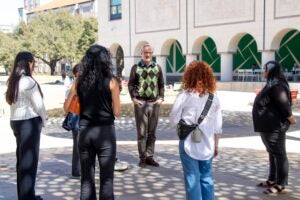AUSTIN, Texas—When University of Texas art historian Dr. Linda Schele was alive, she did more than decode the long mysterious hieroglyphs of the ancient Maya people. She infected others with her enthusiasm about the Maya language and the history it revealed.
Luckily for art historians and other scholars who caught the Maya bug, Schele started an annual forum on the ancient writings in 1977. That forum lives on today and is now known as the Maya Meetings at Texas. This year’s event will stretch from March 11-20 and will draw more than 600 participants from around the world.
Dr. Schele, known to her colleagues and students as “the heart and soul of Maya studies,” died of cancer in April 1998 just a few weeks after she made her final appearance at the annual meetings.
To assure that her work continues, the College of Fine Arts/Art History is raising funds to endow the Linda Schele Chair in pre-Columbian Art and Writing. Dr. Schele helped raise money for the professorship to assure that Texas continues to be a major player in Maya studies.
Among Dr. Schele’s accomplishments was turning Maya studies into a participatory process, opening forums and workshops to the public. Avid amateurs regularly show up at the Maya Meetings to learn more about what the glyphs mean and sometimes to learn to write the ancient language themselves.
For centuries, scholars believed that the picture-like Maya glyphs recorded the movement of the stars. But in 1952, a Russian linguist named Yuri Valentinovich Knorosov discovered that the glyphs are phonetic symbols and that they represent the Maya language.
Linda Schele entered the picture in 1970 when she became captivated by the Maya culture at the ruins of the city of Palenque in Chiapas, Mexico. An art historian, Schele returned to school and received a doctorate in Latin American studies. She later pioneered decoding the Maya glyphs.
The deciphering begun by Knorosov and continued by Dr. Schele was the biggest linguistic discovery since the Rosetta Stone helped scholars unlock the mysteries of Egyptian hieroglyphs. The Maya translation led to a revolutionary view of the ancient Maya people, who had been considered peace-loving stargazers.
The Maya hieroglyphs reveal a highly advanced people with a fully developed language and a detailed calendar. The glyphs also speak of a warring people and their religious and ceremonial rituals.
Today, about 85 percent of the Maya glyphs have been translated. They are the ancestors of the language spoken today by descendants of the ancient Maya nation. These contemporary people live primarily in Guatemala and the Yucatan.
The glyphs were found primarily on pottery, in tombs, and on stair steps. The Mayans, who flourished from about 200 A.D. to 900, developed bark paper and wrote on that as well. However, the books were destroyed by Spanish conquerors who believed the writings were sacrilegious to the teachings of Christianity.
A calendar of events for the Maya Meetings at Texas can be obtained by calling 471-6292.
For more information about the meetings, contact Keeler at 471-6292.



